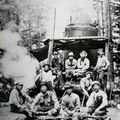Every community has and needs services and other institutions. J-Town Toronto was no different. As I mentioned last month, Dr. Kuwabara (family doctor) and Dr. Nakashima (dentist) had offices at Spadina and Bloor, easily visited even from the core of J-Town. Both were our doctors. Dr. Ku delivered me and several of my Nikkei friends!
The Japanese United Church was relatively nearby at Ossington and Bloor, easily accessed by subway or streetcar (before the east/west subway) back in the day. The Buddhist Church started on Huron Street, near Spadina and Dundas, but it moved to Bathurst and Bloor in a beautifully designed new building. A dispute soon sparked debate between the two churches. Ed Yoshida of the United Church argued that all Nikkei should be Christian to “fit in” with Canadian society. Hideo Ed Yoshida (no relation) cleverly observed that the United Church is identified as and called the Japanese United Church. “How is that Canadian?” he argued.
Weekly newspapers The New Canadian and The Continental Times (later The Canada Times) kept the community informed of events in their Dates and Doings sections. The Continental Times started pre-WWII in Vancouver as the Tairiku Nippo (basically a union paper) and exclusively Japanese. It was shutdown with the beginning of the war. Afterwards, it revived as The Continental Times in English and Japanese. Similarly, The New Canadian started before WWII, in 1939, but as The Voice of the Nisei. It came out twice a week in English only. It could continue (permitted by the government) during the war to keep families in touch with one another and as an organ for government propaganda. The editors took the bad with the good. After being relocated to Kaslo, BC, and then Winnipeg, Manitoba, it landed in Toronto.
Both were located on Queen Street near Spadina, I presume, to be near its readership. The Canada Times moved to Dundas and McCaul Street. Still in the area. My family just lived north of the intersection.
In the 1950s through to the 1970s, The New Canadian and The Continental/Canada Times suffered irrelevance, though both maintained their community events sections. Articles reporting community events dwindled steadily until unsubstantiated articles about cancer cures and Japanese superiority dominated. One article claimed that the Japanese intestine was a quarter inch longer than all other races!
Both papers came to prominence once again for a brief period during the campaign for Redress in the 1980s. Opposing opinions on redress filled the pages, though The Continental Times displayed its bias in advocating for an apology only while The New Canadian printed opinions for individual compensation. The NC to its credit did include opposing articles, however.
Once settled, the two papers declined once again into obscurity, though Sakura Torizuka (an energetic Sansei) and Shin Kawai tried to revive the NC once again. Unfortunately, the audience faded away as did the paper. The Canada Times, on the losing side of redress, lost its readership quite quickly and became mired in scandal before disappearing.
The other important characteristic of J-Town Toronto was nearby Chinatown roughly on Dundas between University Avenue and Bay Street (where the Ginza Café was located). Several restaurants in the area were established and were a favourite of Issei and their families to celebrate significant events like birthdays (42 and 88 come to mind), wedding anniversaries and the like. Families and friends would gather at places like Kwong Chow, Golden Dragon, Sea Hi and Sai Woo to occupy large tables and dine on delicacies like Cantonese chow mein, sweet and sour pork, fried rice, char shiu with tofu and other exotic dishes. I remember one of my courtesy aunts always ordered me and my cousin a bowl of won ton mein because she was kind and we loved it so much. My mother frowned every time, of course.
Kwong Chow was possibly my favourite since its host, Mrs. Jean Lumb, was so congenial, and she had installed a colour television set in the corner of the dining room. Nothing like watching Bug Bunny while slurping won ton soup.
The Nisei too went to Chinatown after every meeting at, say, the Buddhist Church on Huron Street or in the backroom of Nikko Garden (too expensive to have a late-night snack there; not sure they offered snacks anyway). After dances at Hagerman Hall (where some Sansei dances were held in the 1960s), the Odd Fellows Hall, the Legion Hall, or the YWCA on College Street, they went to Chinatown for a bowl of “soba” (wonton soup, a reasonable substitute). I believe, a favourite place was Sea Hi (owned by Mrs. Lumb’s sister).
Today, Chinatown has expanded to Spadina and Dundas but it’s just not the same. All the big and fancy restaurants in the old Chinatown area have closed. Sea Hi moved to the Bathurst and the 401. I hear it’s closing soon. Good, better Chinese food can be found elsewhere, forget tradition. Its time has passed, though it has been immortalized in the amusing documentary I’m Dreaming of a Jewish Christmas. It was shot there.
So, despite the popular belief that J-Town Toronto didn’t exist, I believe it did for a time. I miss it. I hope readers see what has been lost, especially the joy of community, and share my grief.
© 2020 Terry Watada






